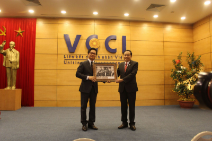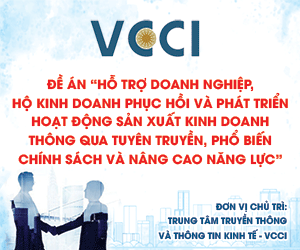Textile-Garment Enterprises Plan to Navigate Global Market Fluctuations
Market fluctuations and high tariffs are familiar challenges for Vietnam's textile and garment industry. The key now is to stay calm, remain determined and committed, and work with utmost efficiency over the next 90 days.

Textile-garment enterprises are proactively pursuing short- and long-term strategies, including exploring new markets and materials and optimizing production
The preliminary results for the first quarter of 2025 from the Vietnam Textile and Garment Group (Vinatex) indicate that its consolidated revenue is estimated at VND4,417 billion, up 6.1% compared to the same period last year. The consolidated profit is estimated at VND271 billion, up 165.5% from the same period in 2024.
Proactive solutions for short term and long term
To achieve these growth results, Vinatex reported that many textile-garment enterprises turned a profit in the first three months of the year. Additionally, all garment units showed strong production and business performance. Currently, most companies in the industry have orders secured until May 2025.
However, since the last week of February 2025, the textile and garment market has seen declines in both price and demand due to U.S.-China trade tensions, with cotton prices continuously falling. Most orders are now being finalized based on specific needs, requiring faster delivery, and selling prices are closely aligned with market fluctuations.
In the garment industry, many businesses have secured enough orders through the end of the second quarter of 2025 and are negotiating for the third quarter. However, in the first quarter, orders have been expedited to mitigate any potential impact of U.S. tariff policies, while orders in the second quarter of 2025 are slowing down as businesses await changes in U.S. tax policies.
Previously, when the U.S. announced new reciprocal tariffs and planned to impose the tariffs on April 3 (Vietnam time), many customers temporarily suspended their orders, leading to a slowdown in the market and production. However, following the announcement on April 10 about the temporary suspension of the tariffs, customers expedited production and delivery, requiring orders to be completed within the next 90 days.
In addition, businesses have proactively developed both short-term and long-term strategies, focusing on negotiating with customers in a spirit of cooperation, exploring new export markets and raw material sources, optimizing production management, and accelerating the production of orders secured for the second quarter.
According to Vinatex's assessment, demand for textile and garment products in the U.S. market may not decline sharply, as inventories have returned to low levels after COVID-19, and there are expectations for more positive signals from tariff policies. However, the Vietnamese textile and garment industry also needs a backup plan in case Chinese textiles are unable to be exported to the U.S. due to high tariffs, which could impact other major markets such as the EU, Japan, Korea and the domestic Vietnamese market.
Maximizing production in 90 working days
In light of these developments, Vinatex leaders assessed that this is a critical period, requiring the entire system to operate with a sense of urgency while maintaining calm and clarity in production and business activities.
Mr. Le Tien Truong, Chairman of the Board of Directors of Vinatex, said that market fluctuations and high tariffs are not new challenges for Vietnam's textile and garment industry, which has weathered many difficulties in the past and continues to overcome them, solidifying its position as the second-largest exporter in the world.
Truong emphasized, "The most important thing right now is not to panic or worry, but to remain steadfast, courageous and united, and to be ready to work with the highest efficiency over the next 90 days."
At this time, all units within Vinatex must activate a close coordination mechanism similar to the one used during the COVID-19 period, including standardized working methods, approaches and information sharing across the group. Additionally, it is important to accumulate reserve funds at the units to prepare for the worst market scenario.
In parallel with production activities, the Vietnam Textile and Garment Trade Union has launched Workers' Month 2025, focused on fostering labor production and maximizing output through 90 days of rapid work. Vinatex unit leaders and trade s will work together to inform and mobilize workers, ensuring they understand market developments, remain calm and focused, and make every effort to complete second-quarter orders by July 5, 2025.
Along with the production campaign, Vinatex leaders have tasked the Garment Production and Business Board with studying the raw material supply chain and prioritizing the use of fabrics from enterprises within the group, provided they meet quality standards. Simultaneously, the Group is assisting enterprises in classifying each item and market that may be impacted by new tax policies, providing a basis for negotiations with customers and identifying appropriate strategies moving forward.
Shareholders are also urged to collaborate with units during these challenging times, offering support, resources and solutions. The group will focus on ensuring transparency in rules of origin and compliance with anti-commercial fraud regulations. Additionally, it will continue guiding businesses to diversify their products, supply chains and markets to reduce dependence on a limited number of existing markets.
In addition to providing timely updates and flexible, practical guidance to businesses, Vinatex will actively propose policies to the State and Government to support businesses and workers, ensuring stable production, employment and income across the entire system.
The main concern now is awaiting positive outcomes from the Government's negotiating delegations. As an industry contributing approximately 14% of Vietnam's total export turnover to the U.S. and employing nearly 1 million direct workers in businesses serving this market, Vinatex leaders have proposed allowing representatives from its Executive Agency to join the advisory group, assisting the Government's delegation in reporting and addressing issues related to the textile and garment industry.








